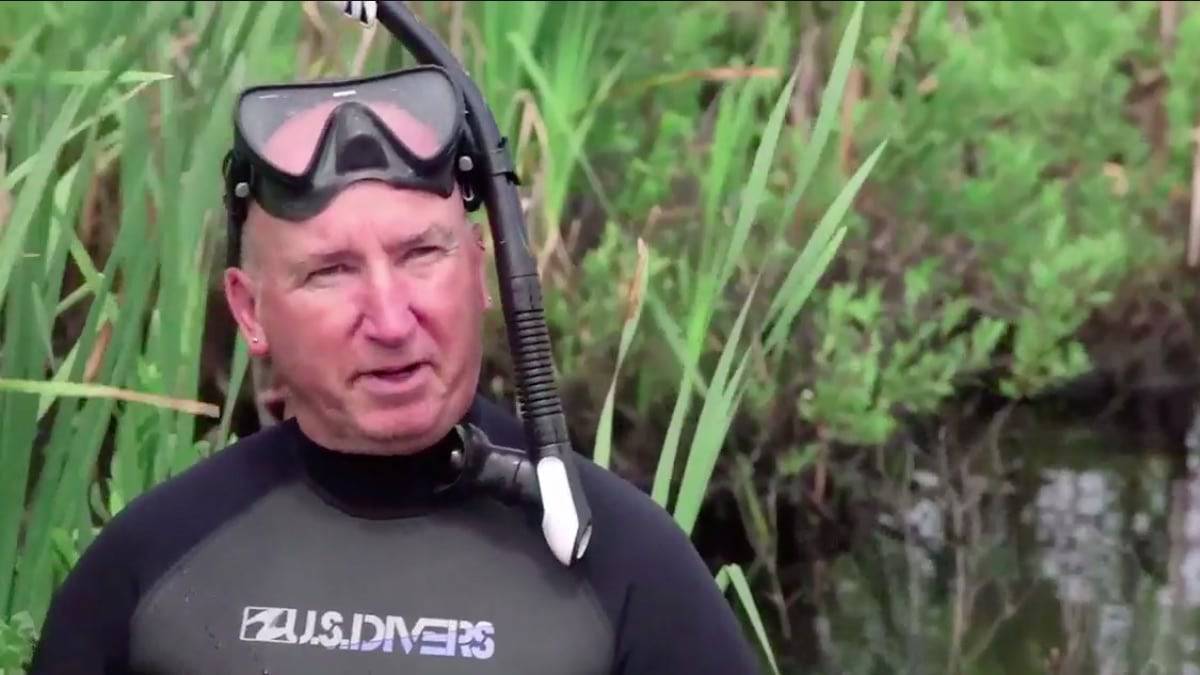
On The Curse of Oak Island this week, it’s time to drain the swamp! Meanwhile, Rick and Marty Lagina and their treasure-hunting team discover DYNAMITE 90ft down in the mud beneath Smith’s Cove.
The episode also saw the team reconnect with the expert tasked with finding out more details about the swamp anomaly, and they traveled to Halifax to gather more data about the swages found last week by metal detecting expert Gary Drayton.
Read our full recap of The Curse of Oak Island Season 7 Episode 3 below!
As things get under way on this week’s episode, the team meet with environmental geoscientist Dr. Ian Spooner who has an initial report based on data from core samples from the swamp.
His findings revealed that every centimeter of sediment correlates to roughly ten years’ worth of time. He has also found a “depressed feature” on the landscape, which he describes as, “fairly young…back 300 to 400 years.” When asked if this feature is it manmade, he responds in the affirmative.
Marty describes the feature as an “oddity” and says it is “more complex” than he first thought. He also said it might indicate that at one time there were two islands, not just one.
Later the team arrive at the swamp with surveyor Steve Guptill to follow up on the rock formation identified by Spooner. Is it a manmade rock wall?
Drayton gets into the swamp and finds metal six feet below the surface. According to him, his detector is getting short, rapid vibrations which indicates there is iron in the rock formation. Guptill uses GPS to record and plot the dimensions of the mysterious stone formation which Marty calls, “the eye of the swamp.”

He declares that in the swamp there is, “enough interesting anomalous stuff”, adding, “I want to see it, I want to know what it is.” His verdict? “We need to drain this puppy.”
After analyzing the GPS data, Steve later reports the findings indicate a ring of rocks, with one of the formation objects being an exception, possibly a pointer object. According to Rick, this singular object could have been developed by man. The team agree that the data is intriguing enough to necessitate draining the swamp in order to literally get to the bottom of things.
Next, the team hire Shawn Wilson of Wilson Excavation Limited, who is charged with performing a large-scale excavation. For now there are three target areas — the spot where seismic scanning identified a 200 foot object initially hoped to be a ship or galleon, the stone wharf discovered by diver Tony Sampson, and the area described by Spooner, what Marty has termed the eye of the swamp.
In order to accomplish the project, Wilson must create a dig box consisting of four metal barriers which will serve to isolate the dig area thus preventing cave-ins and serving as a place to store spoils. When constructed, the dig box, also known as a trench cage, will be 16 feet square and weigh 2 to 3 tons.

Meanwhile, Alex Lagina, Peter Fornetti and Charles Barkhouse travel to St. Mary’s University in Halifax where Christa Brosseau, associate professor of chemistry, will scientifically examine the two metal swages found last week.
She is told that blacksmithing expert Simon Legge identified them as tools used to sharpen rock chisels. Could these swages be evidence of tunnel building, and possibly medieval?
She and her colleague Xiang Yang use a high-power electron microscope which can magnify an object to 200,000 times its actual size. They determine there is no manganese in the objects, and state it is, “hard to nail down a date, but estimate they could be pre-1840.
Hearing this, Marty declares it to be a, “potentially exciting scientific report,” and that the objects could be associated with either a recovery or deposit operation. Rick notes the swages are unlike any other artifacts found on the island.
Elsewhere, at the upper beach at Smith’s Cove, geologist Terry Matheson meets with a representative from Choice Drilling. The team hope to locate the five stone box drains first discovered in 1850. If they can find the convergence point it may lead them to the Money Pit; the goal is to connect the dots between the Smith’s Cove work and the Money Pit.
At a depth of 69 ½ to 73 ½ feet the core samples are more moist and contain more boulders than the previous sample, which is declared a little bit of a disappointing find.

At 91 feet, an area termed the zone of interest, they find amorphous material consisting of soft clay and lots of little stones. According to Matheson, this is significant and indicates that something has been broken apart.
At 99 feet the soil is breaking apart well, and Matheson smells charred or burnt material when Oak Island historian Paul Troutman finds a fingernail piece of dynamite.
This discovery is called, “Incredible, what a find!” At a depth of 95 feet a chunk of tube which would have held the dynamite is found.

According to Matheson, this validates the version of events that had the Oak Island Treasure Company creating boreholes, circa 1897 to 1898, in which to set off dynamite with the hope of digging to the Money Pit.
This leads the team to speculate that the flood tunnels are in this approximate area, and Matheson states the team is is now searching exactly for what they were searching for back in the day.
As the team continue to drill and dig upon and below Oak Island, where will their efforts lead — to a treasure vault full of riches or will the island reveal yet more secrets and possible danger?
The Curse of Oak Island airs Tuesday nights at 9/8c on History.